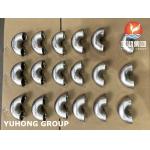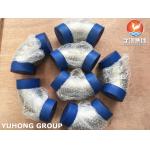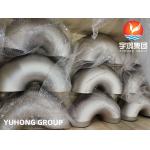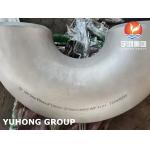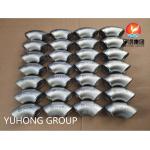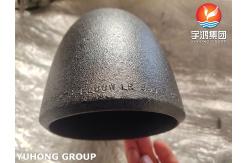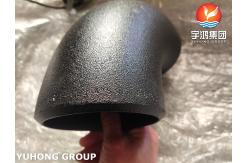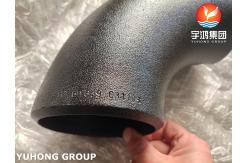ASTM A234 WP5-S Carbon Steel Fittin Ecentric Reducer Seamless For
Pipe ConnectionThe ASTM A234 WP5-S Carbon Steel Butt Welded Eccentric Reducer is an essential component for connecting pipes of different
diameters in high-pressure and high-temperature applications.
Manufactured from high-strength WP5-S carbon steel and conforming to ASME B16.9, this fitting ensures durable, reliable, and efficient pipe
connections in a variety of industries, including oil & gas, power generation, and chemical processing. Its butt welded design offers a permanent, leak-proof connection, while the eccentric reducer ensures smooth fluid flow and energy efficiency.Key Features:Material: ASTM A234 WP5-S Carbon Steel
ASTM A234 WP5-S is a high-strength, low-alloy carbon steel material that is
specifically designed for high-temperature and high-pressure
applications. This material is known for its excellent mechanical
properties, including good weldability, and is commonly used in the
manufacturing of pipe fittings, valves, and flanges in industries
such as oil & gas, power generation, and chemical processing. Fitting Type: Eccentric Reducer (Butt Welded)
The eccentric reducer is a type of pipe fitting used to connect two pipes of different
diameters while maintaining a consistent centerline. This design
helps avoid sloping of the system and ensures that the fluid or gas
flows smoothly through the pipe system, especially in applications
where the flow direction needs to remain stable. The butt welded connection method ensures a strong, leak-proof joint between the
pipes, making it ideal for high-pressure and high-temperature
applications. Standards: ASME B16.9
The ASME B16.9 standard provides specifications for factory-made butt welded
fittings. It includes dimensional, material, and pressure rating
requirements for fittings like reducers, elbows, tees, and caps,
ensuring compatibility and reliability across various piping
systems. Application: Pipe Connection for High-Pressure Systems
The eccentric reducer is used to transition between pipes of different diameters in a
pipe system. It is commonly applied in systems where space is
limited, and a smooth, stable flow of gas or liquid is necessary.
Typical applications include power plants, chemical processing, oil & gas pipelines, and HVAC systems.
Chemical Composition:| Element | ASTM A234 WP5-S Carbon Steel |
|---|
| Carbon (C) | 0.05% - 0.15% | | Manganese (Mn) | 0.30% - 0.60% | | Phosphorus (P) | 0.025% (max) | | Sulfur (S) | 0.025% (max) | | Chromium (Cr) | 2.25% - 2.75% | | Molybdenum (Mo) | 0.90% - 1.20% | | Silicon (Si) | 0.10% - 0.50% |
Mechanical Properties:| Property | ASTM A234 WP5-S Carbon Steel |
|---|
| Tensile Strength | 485 - 620 MPa | | Yield Strength | 205 MPa (min) | | Elongation | ≥ 20% | | Hardness | Brinell hardness: 170 - 230 HB |
Advantages:High Strength and Durability: The ASTM A234 WP5-S material provides the necessary strength to withstand high
pressure and high temperatures, ensuring the longevity and
reliability of the eccentric reducer in demanding environments. Butt Welded Connection: The butt welded fitting ensures a strong and permanent connection between pipes,
providing a leak-proof joint. This type of connection is highly
reliable in high-pressure and high-temperature applications. Smooth Fluid Flow: The eccentric reducer design helps to maintain a smooth and stable flow of fluids or
gases, preventing turbulence and air pockets, which is essential
for applications in pump systems or where precise fluid control is
necessary. Corrosion Resistance: The alloying elements such as chromium and molybdenum in WP5-S provide enhanced resistance to oxidation and corrosion,
particularly in high-temperature and aggressive environments. Versatile Application: The eccentric reducer can be used in a wide range of applications, including power plants, oil and gas, chemical processing, and HVAC systems, offering a reliable and durable solution for connecting pipes of
different diameters.
Applications:- Power Plants: Used to connect pipes of varying diameters in steam, water, and
gas piping systems.
- Oil & Gas: Applied in pipelines for transporting liquids, gases, or crude
oil, where high-pressure connections are necessary.
- Chemical Processing: Used in chemical plants for connecting pipes in high-temperature
and high-pressure systems.
- HVAC Systems: Used for pipe connections in large-scale heating, ventilation,
and air conditioning systems where reliability is critical.
|
